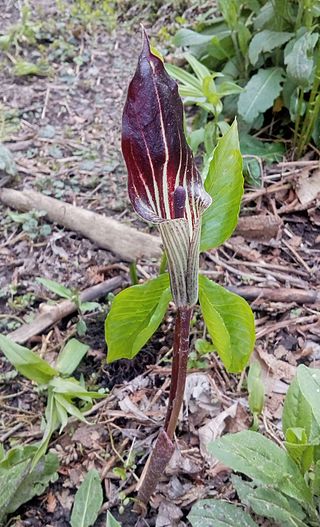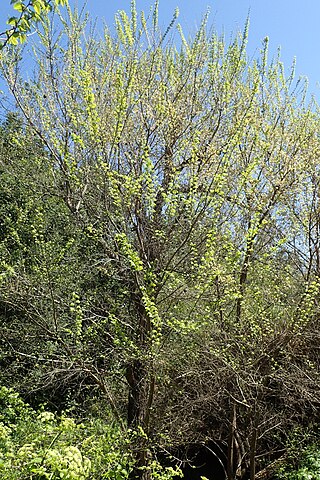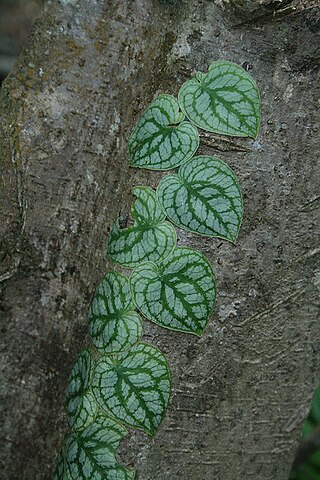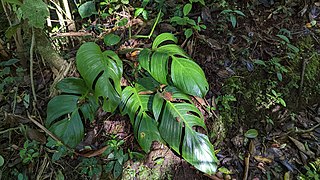
Monstera deliciosa, the Swiss cheese plant or split-leaf philodendron is a species of flowering plant native to tropical forests of southern Mexico, south to Panama. It has been introduced to many tropical areas, and has become a mildly invasive species in Hawaii, Seychelles, Ascension Island and the Society Islands. It is very widely grown in temperate zones as a houseplant.

Monstera is a genus of 59 species of flowering plants in the arum family, Araceae, native to tropical regions of the Americas.

Arisaema triphyllum, the Jack-in-the-pulpit, is a species of flowering plant in the arum family Araceae. It is a member of the Arisaema triphyllum complex, a group of four or five closely related taxa in eastern North America. The specific name triphyllum means "three-leaved", a characteristic feature of the species, which is also referred to as Indian turnip, bog onion, and brown dragon.

Papuacedrus papuana is a species in the conifer family Cupressaceae, the sole species in the genus Papuacedrus. Some botanists do not consider this species as forming a distinct genus, but include it in the related genus Libocedrus. It is native to New Guinea and to the Indonesian Province of Maluku.

Ulmus minorsubsp.canescens is a small deciduous tree occasionally known by the common names grey elm, grey-leafed elm, and hoary elm. Its natural range extends through the lands of the central and eastern Mediterranean, from southern Italy, the islands of Sicily, Malta, Crete, Rhodes and Cyprus, to Turkey, and as far south as Israel, where it is now considered rare and endangered in the wild. The tree is typically found amidst the comparatively humid coastal woodlands and scrublands.

Epipremnum is a genus of flowering plants in the family Araceae, found in tropical forests from China, the Himalayas, and Southeast Asia to Australia the western Pacific. They are evergreen perennial vines climbing with the aid of aerial roots. They may be confused with other Monstereae such as Rhaphidophora, Scindapsus and Amydrium.

Monstera epipremnoides is a species of flowering plant in the family Araceae, endemic to Costa Rica. A clone in cultivation was formerly thought to be of this species, but after comparison with wild populations of M. epipremnoides, the plant in cultivation has since been registered as a cultivar of the name Monstera 'Esqueleto'.
Monstera standleyana, the five holes plant is a species of flowering plant from family Araceae which can be found in Costa Rica, Honduras, Nicaragua, and Panama. It was described by G.S. Bunting in 1967.

Monstera acuminata, or shingle plant, is a species of flowering plant from family Araceae which is widespread from Mexico to Central America. It is abundant in central Petén and extends north to San Luis Potosí, making it the northernmost of the species of Monstera.

Monstera dubia is a species of plant in the genus Monstera native to Central and South America. M. dubia is known for the dramatic transformation its foliage makes as it climbs from seed stage on the forest floor, to shingling closely up a host tree trunk or other surface, until mature leaves with fenestrations similar to Monstera deliciosa appear. This transformation is an example of leaf dimorphism. Dubia refers to dubious, because authors were not certain that the species fell within the genus Marcgravia, where it was initially placed.

Monstera obliqua is a species of the genus Monstera native to Central and South America. It is hemiepiphytic like most other Monstera species. The plant is particularly known for its foliage, which is often highly perforated, sometimes described as having more empty space than leaf. An illustration of the general variation in adult leaf shape from different individuals of this species can be found in Michael Madison's A Revision of Monstera. The species is not commonly cultivated, but the name is often misapplied to specimens of the more widespread Monstera adansonii.

Monstera anomala is a flowering plant of genus Monstera and family Araceae.
Monstera boliviana is a flowering plant belonging to genus Monstera of family Araceae.
Monstera oreophila is a flowering plant in the genus Monstera and family Araceae.
Monstera aureopinnata is a flowering plant in genus Monstera of family Araceae. It is an epiphyte.
Monstera minima is a species of flowering plant in the genus Monstera of the arum family, Araceae. Its binomial name minima refers to its tiny foliage, and it is indeed the smallest of the Monstera species when it comes to leaf size. It is most easily distinguished from other species in the genus due to the fact that its peduncles are much longer than its leaves.

Monstera monteverdensis is a species of flowering plant in the arum family, Araceae. Its adult form is characterized by pinnatifid margins with up to eight lobes per side, with occasional fenestrations away from the midrib. Leaves can grow as large as 60 cm long and 30 cm wide. It is named after the city of Monteverde, where the species is abundant.
Monstera subpinnata is a species of flowering plant native to Bolivia, Peru, Ecuador and Colombia. It grows as an epiphyte. The plant is best known for its pinnate leaves, which are unusual within the genus Monstera. The species can grow as tall as 12 m, with leaves growing as large as 40 cm long and 30 cm wide.

Monstera tuberculata, also called the giant Monstera or the giant velvet-leaf Monstera, is a species of plant in the genus Monstera native from Mexico south to Panama. It grows in lowland wet tropical biomes up to 200 metres (660 ft) in elevation. Similar to Monstera dubia and a few other species in its genus, when young M. tuberculata has a shingle-like growth habit with leaves tightly pressed against the trunks of trees. As it matures, it has short-stemmed, oval leaves that lack the fenestrations of better-known species like Monstera deliciosa. Unusually for an aroid, its fruit hangs like a pendant.
Monstera alfaroi is a flowering plant in the arum family. It is endemic to mid-altitude premontane rainforests of Costa Rica at altitudes of 1,100 to 1,250 metres. M. alfaroi features light brown petioles with black or white warts. It is closely related to Monstera buseyi, but M. alfaroi can be distinguished by its larger inflorescence. M. alfaroi is also easily confused with M. costaricensis, which can be distinguished from M. alfaroi by its petioles with white pustules, more conical inflorescence, and location; M. costaricensis only occurs in lowland areas of Costa Rica below 600 metres (2,000 ft). Mature plants have ovate leaf blades as long as 90 centimetres (35 in) and 45 centimetres (18 in) wide, with few circular fenestrations near the midrib. From petiole to blade tip, M. alfaroi leaves can be up to 160 centimetres (63 in) long. It has a white spadix and an externally light green spathe. Flowering has been recorded in November, and fruiting in January.













